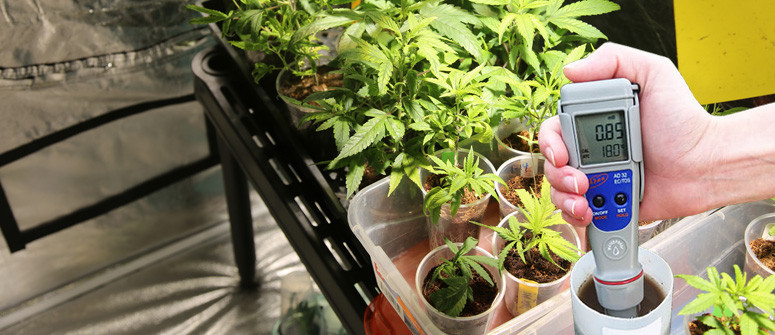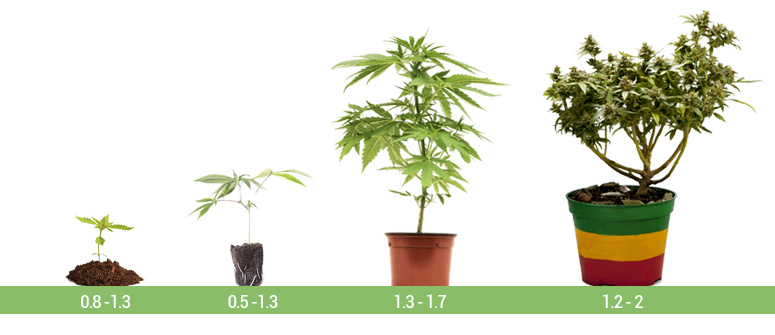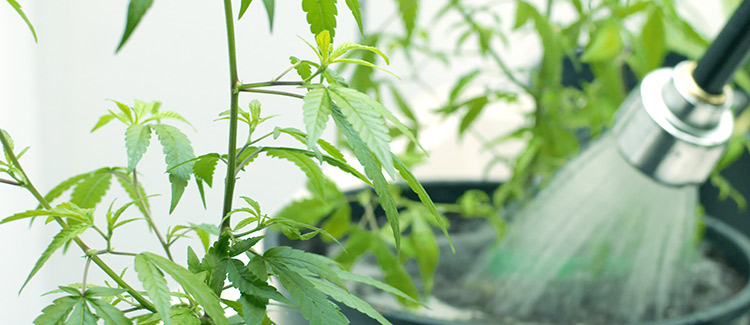The ideal ec range for cannabis plants

EC stands for 'Electrical Conductivity' and is a measurement scale for the concentration of chemicals in your nutrient solution. More at CannaConnection!
Tap water is not the same anywhere. Water content is always different, and the grower needs to know what type of water plants are receiving. Above all, the concentration of the nutrient solution directly impacts plants’ health, growth and yield. Measuring the concentration of a nutritive water solution is a fundamental job for cultivating healthy plants and yielding good products.
Nutrient balance and concentration is the first thing a grower should focus on in order to prevent their plants from nutrient deficiencies and/or overfeeding. Always consider, that a plant might never fully recover from a nutrient lockout or an excess of nutrients.
HOW EC WORKS FOR THE GROWER
Pure distilled water does not efficiently conduct electricity. Real world tap water contains enough substances with H+ Cl- ions, which it make possible to conduct electricity almost like a metal cable. Plus, the salts contained in all agricultural nutrients add more ions with positive and negative electrical charges, that attract one another.
When we add fertilizing compounds to tap water, these chemicals increase water electrical conductivity, and a greater concentration of nutrients in water results in a liquid, that conducts more electricity. This conductivity is measurable, and its figure shows how much fertilizer is contained in water.
We can measure how much electricity is conducted by a water solution and obtain the concentration level of ionic salts in that particular water. The most used scales for measuring the concentration of chemicals in water are electrical conductivity (EC) scales, and the parts per million (ppm) scale. This last one is also named total dissolved solids or TDC scale.
Many factors can alter the EC (or ppm) balance of a solution, including irrigation, evaporation and nutrient uptake by roots. If the growing substrate is under-watered or allowed to dry on hot days when more water is taken up from the soil or from the solution, the EC measurement will increase even two or three times higher, causing an excess of salts in the root area.
In a situation where EC has doubled, the amount of sodium is likely increased four to six times higher than the normal average amount found in tap water.
EFFECTS OF HIGH OR LOW EC ON CANNABIS PLANTS
Plants’ cells start losing water when the salt concentration is too high and the EC of the nutrient solution increases. The first exterior sign of distress caused by excess of nutrients is wilting leaves. Foliage growth can become harder, darker and brittle. Plants stop growing, staying shorter with smaller leaves. Brittle leaves are the product of a high EC.
Some commercial growers are able to pump enough nutrients into their blooming plants without causing damage. The result is often fruits with a harsh taste due to the excess of salts in plant tissues during flowering stage. On the opposite, a low nutrient concentration causing low EC forces more water uptake from the roots.
As a result, the foliage becomes weak and soft, often lighter green or pale. A low EC condition is more easily rebalanced than a high concentration of nutrients already flowing in the system.
HOW TO CHECK THE NUTRIENTS CONCENTRATION WITH EC MEASUREMENT
A chemical analysis of the water used for cultivation purposes is always advisable. This will indicate the dissolved ionic salts already in solution. “Hard” water contains high levels of calcium and magnesium, while “soft” water has so few ionic salts, that might require calcium compounds to be added to the nutritive solution.
If no water analysis is available, an EC measurement of the overall concentration of the dissolved solids (ionic salts) is highly recommended. Use an electronic EC pen to regularly monitor the level of dissolved solids in the solution.
A good EC (or ppm) measurement is made by collecting water samples from the reservoir, growing medium and runoff. Testing EC and pH simultaneously is a good way to optimize operations. These readings should be taken at the same hour every day. Place each sample in a clean jar and use a calibrated EC meter to measure each of the samples. Keep constant record of EC and pH measurements.
Under normal conditions, the EC in the growing media and runoff should be just a little higher than the nutrient solution in the reservoir. If the EC of the solution drawn from the growing medium is higher than the one from the reservoir, there might be starting a fertilizer salt build-up.

An indicative EC range for cannabis plants is 0.8-1.3 for seedlings; 0.5-1.3 for clones; 1.3-1.7 under vegetative phase; 1.2-2 during flowering. Different varieties of cannabis might require significantly different values of EC.
HOW TO CORRECT EC LEVELS AND MANTAIN THE RIGHT NUTRIENT CONCENTRATION

When EC measurement is too high in the growing media and runoff, the plants are at risk. The only countermeasure is leaching the substrate thoroughly with water, add a diluted nutrient solution, runoff, and replace with new balanced nutritive solution.
The runoff carries away the excess fertilizer. Let a minimum of 20% of the nutrient solution drain from growing media after each irrigation cycle. This dramatically reduces the risk of salts build-up. To lower the EC level, just increase the runoff to 30% of the solution. To raise the EC, add more fertilizer to the solution, or change the nutrient solution.
Water evaporation increases the nutrient concentration. Regularly add plain water to the nutrient solution to replace the one absorbed by plants. Measure EC daily and adjust the nutrients concentration according to changing growing conditions. Always lower EC when external temperature increases over normal levels.
THE EC ISSUE IN HYDROPONIC CULTIVATIONS
The EC (or ppm) values are much more important for hydroponic growers than any others. Hydroponic and aeroponic grow methods use direct feeding devices, which require a perfect control of the chemical compounds and values of fertilized water.
The best way to avoid problems is draining the irrigation system and adding fresh solution regularly. Always keep the reservoir full at all times and add more fertilizer to maintain the EC level in the reservoir during “topping off”. An automatic filling function for smaller reservoirs will help ensure a balanced nutrient solution. Leaching the system with mild nutrient solution for an hour or more between changing the reservoir avoids a lack of nutrients even for a short time.
A reverse osmosis filter is able to remove ionic salts from tap water. This kind of cleansing technology really improves water quality by filtering out any salt build-ups, thus increasing the absorption of nutrients by the roots system. If the EC of tap water is 0.3 or higher, the water should be treated with a reverse osmosis filter before adding nutrients.
Water quality is very important, and requires some work. Always remember, that every growing technique, and each variety of cannabis have an ideal EC range for optimum growth and blooming.




